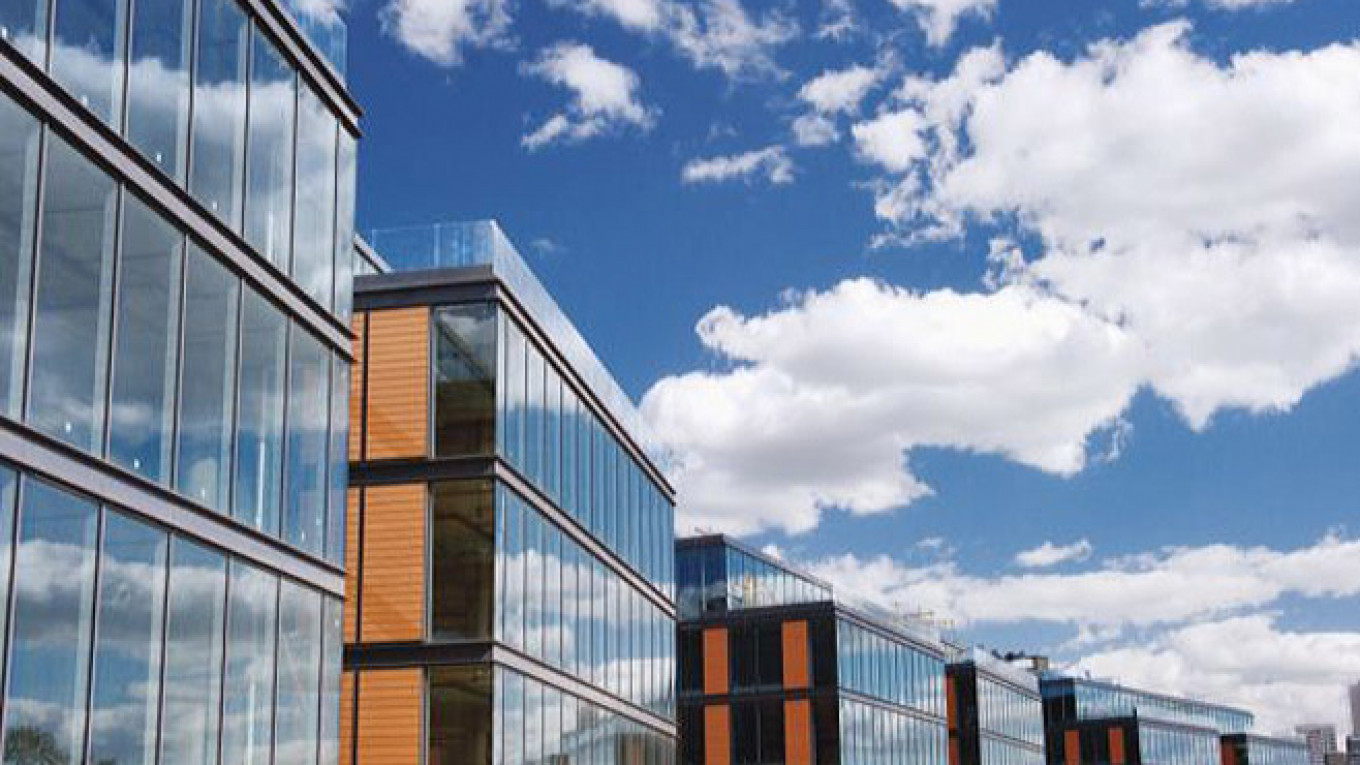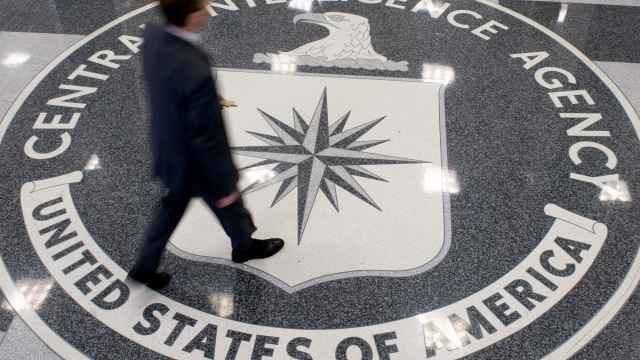Resource-efficient "green" buildings have low operating costs. They emit low levels of pollution, which is good for the health of occupants, and have a negligible impact on the surrounding environment.
In a nation where utilities are heavily subsidized by the government, however, local investors don't see justification for the extra spending on such construction. A lack of locally available green materials is also a downside.
At the same time, end users and international investors increasingly favor office buildings with green features, and experts predict that the green-building trend will gradually grow stronger on the office market. Several new offices in Moscow plan to receive green certification.
"Green building is not popular in Russia because it is not mandated and not historically something that tenants look at," said Darrell Stanaford, a former managing director at real estate agency CBRE who's been working in Russia for 16-plus years. Gradually, however, this situation is changing due to several reasons, he said.
"In the future there will be a better supply-and-demand balance, and suppliers need to differentiate themselves," Stanaford said. "Office space tenants also want to provide better conditions for workers."
Resource-efficient features are attractive to buyers.
"Green can make a substantial difference for international investors looking to sell a property within five years," Stanaford said.
Several office centers are already going green. International tech conglomerate Siemens has a new green office near the Novokuznetskaya metro station. This summer, realty multinational Jones Lang LaSalle will move into a green office at the newly constructed Vivaldi Plaza, near Paveletsky Station. Finally, BMW and homegrown computer-security firm Kaspersky Lab are the initial tenants at Olympia Park, a green office complex. All three office centers are?planned to undergo green certification.
"Western companies want green certification when available. It's a checklist item for them," said Franc Neal, a green-building specialist at CBRE. "Most Fortune 500 companies require green buildings."
"Occupiers want green not only because it saves money but because workers are happier and more productive," Neal added. "Owners want a green building because it's valuable."
Trending Green
In December 2010, Ducat Place III, which is located close to the intersection of Tverskaya and the Garden Ring, became Russia's first commercial building certified with British green-building standard BREEAM. The 14-story Class A office building, completed in 2006, got approved after the developer, Hines, upgraded the lighting and sanitation systems.
Western companies want green certification when available. It's a checklist item for them.
Franc Neal, CBRE
In November 2010, a factory operated by Swedish rolling-bearings manufacturer SKF Group in Tver, some 150 kilometers north of Moscow, became the first commercial building in Russia to be approved for the U.S. green-building certification LEED.
The St. Petersburg Ecological Union offers a local green certification for environmentally safe building materials. The organization's Vitality Leaf seal is awarded to materials that meet a set of international green standards developed by the International Organization for Standardization.
A strategic partner of the St. Petersburg Ecological Union is the Russian chapter of the World Green Building Council. Neal, the green-building specialist at CBRE, is a founding board member of that chapter.
"Another major driving force for going green in Russia is a new generation of local architects with degrees from Western universities," Neal said.
"The financial crisis also helped local green building because it provided a long gestation period" for green ideas, since new development slowed to a trickle, Neal added.
"This next construction cycle is going to be greener," he said.
Christoph Woop, a German architect who works locally at BRT Rus, said he incorporates green design elements into all of his projects.
"There is a global focus on sustainability, to build a building that does not influence its surroundings," Woop said. "You use stone from the region. You reuse an existing building; for example, the remodeling of the former Red October chocolate factory."
Building green has a variety of advantages, according to Woop. For instance, converting the interiors of existing buildings into green-standard ones, while leaving exteriors untouched, preserves the architectural fabric of the city, he explained.
"Green is an emphasis on solutions that are sustainable: solar energy collection, ground water heating," Woop said. "It's good to have a green roof or light roof with natural ventilation."
A truly green approach also excludes many chemicals and building materials, he added.
Finally, a green-building certification can also be a status symbol.
"The Skolkovo Technopolis is one of the most prestigious architectural projects in the Russian Federation, and those buildings need to meet green standards," Woop said.
Office Pioneers
In Moscow, the offices of BMW, Jones Lang LaSalle and Siemens are ready to undergo green certification.
Olympia Park, where Kaspersky Lab and BMW Group Russia are the first tenants, is a 70,500-square-meter Class A business complex, with three office buildings, a fitness center and an outdoor park alongside the Khimky reservoir. It opened in July 2011.
As long as utilities are subsidized, the payback period on energy-efficient solutions will be longer than many investors' targets.
Adrian Salter, MEP Engineering
All buildings at the complex are ready to be BREEAM-certified. Kaspersky Lab's deal to rent the largest space, almost 30,000 square meters, was one of the biggest real estate deals of last year. The area is located just outside downtown Moscow on Leningradskoye Shosse, near the Vodny Stadion metro station.
Jones Lang LaSalle, which has completed more than 150 LEED and BREEAM projects worldwide, is moving into the almost finished Vivaldi Plaza business center. The firm signed a lease for 3,000 square meters of the center's Class A office space in early February.
Vivaldi Plaza, which is managed by Russian firm O1 Properties, is set to undergo certification for both the LEED and BREEAM standards. The site has four office buildings and a four-star Marriott Courtyard hotel, with a total area of 109,000 square meters.
Multinational tech firm Siemens has a new office at 13 Bolshaya Tatarskaya Ulitsa. The interior, which won the Organization of Space award at the Best Office Awards 2011, was completed by local firm ABD Architects.
The six-story building, which also has two levels of underground parking, is set to undergo certification for the LEED standard. It features a spacious atrium that allows in plenty of sunlight, as well as energy-efficient lighting in the offices.
If these business centers receive green certification, they will join a select group of buildings in Eastern Europe with green certification, the number of which can currently be counted on one hand.
"The real estate industry is still at an early stage of development when one thinks about green technology to achieve energy-efficient and sociably responsible projects," Adrian Salter, general director of advisory firm MEP Engineering and a member of the Urban Land Institute, said in an e-mail.
Salter's firm is currently designing new office fit-outs for clients that have requested green solutions such as intelligent lighting systems, metered and energy-efficient air conditioning and heating systems to make an office space run more efficiently and achieve an internationally regarded green certificate such as BREEAM, LEED or the German DGNB standard.
An Unbalanced Equation
Today, investors and developers are loath to add green technology to their capital expenditures, since this will lengthen the return-on-investment period, Salter said. The other factors in this calculation — the cost of utilities such as water, electricity and gas — are still heavily subsidized by the Russian government.
"However, the end users of real estate projects are now looking to minimize their operational expenses, and the [operating expense] of an office space is probably not a large part of their overhead factor but still an area where a saving can be made," Salter said.
"As long as the government continues to heavily subsidize utilities, the payback period on energy-efficient solutions will continue to be longer than many investors' targets, and thus excluded in the development of new buildings," he added.
Another problem that only the government can solve is the lack of infrastructure that is needed to facilitate another green-building strategy — the recycling of construction materials and garbage, Salter said.
"In a mature construction market there is no premium to be paid when insisting on recycled products because the local industry can readily provide them," he said. "But in this part of the world, where such infrastructure for collecting and processing of 'waste' material is almost nonexistent, the cost of using products made from recycled materials is often higher and thus overlooked by investors."
The government can help by providing subsidies for socially responsible infrastructure, Salter said.
The materials needed for green construction are not readily available in Russia, and importing products such as carpeting and lighting requires a lot of energy, which goes against a fundamental principle of green building, said Neal of CBRE.
"Resources need to be acquired nearby; for instance, granite from the Baltic, one time zone away, instead of from Siberia," Neal said.
Green building is about conserving energy not just while the building is in use but throughout the structure's entire life cycle, said Woop, the architect.
"The primary energy that is used to produce the building also needs to be low," Woop said. "Different building materials require different amounts of energy to produce. For example, building an aluminum window frame requires several times less energy than a wooden one."
New Trends in Office Space Design
International tech conglomerates Philips and Siemens both have new offices in Moscow with a common theme: flexible space.
The traditional model of fixed workplaces has been abandoned in favor of open spaces, where workers can set down their laptops and work wherever they want. In theory, this allows employees from different departments to work side by side, to easily exchange ideas and build a sense of community.
Philips' office at Marr Plaza, a Class A business center just within the Third Transport Ring near Moskva-City, is dedicated to "flexibility, mobility and active interaction between people," the firm said on its website.
Each employee can choose a workplace depending on his or her plans for the day, Philips said. The office is divided into areas for individual and collaborative work, leisure, meetings and conferences, each with its own design. The office is divided into 10 themed areas: Russia, the 1950s, Paris, Nature, Mountains, Ocean, Holland, New York, Rome and Avant-Garde.
"This environment increases efficiency and makes people more open," Cezary Piskorz, HR director at Philips Russia, CIS and Central Asia, said in a press release. "All employees, including top managers, work side by side. This provides an opportunity to talk more, avoid formalities, share experience and raise the level of trust in the team."
The new six-story Siemens building, downtown near metro Novokuznetskaya, also centers on a flexible work area. The second, third, fourth and fifth floors are completely open space.
The interior, designed by local firm ABD Architects, also incorporates enclosed 2.7-by-2.7 meter spaces. The glass-paneled sides of these "think tanks" feature trunks of birch trees, a typical symbol of Russia, depicted in frosted glass.
Philips, as the world's largest manufacturer of lights, showcases "comfortable and inspiring" lighting solutions in its new office. The lighting varies depending on the purpose of each location and is energy-efficient. The open work areas make use of daylight cast evenly around the room, while the sites for individual work and negotiations feature adjustable lighting. The leisure areas are accented with multicolored lights.
The Siemens building also pays close attention to lighting. The architects almost entirely opted against broad overhead lighting in favor of individual light fixtures equipped with motion detectors and light-volume sensors. LED downlights are featured in a few main corridors. Such energy-efficient solutions are geared toward certification under the LEED green-building standards.
In addition, new Moscow office buildings often include amenities such as restaurants, gyms and places to relax. The Dvintsev business center, just outside the Third Transport Ring near Savyolovsky Station, has a Prime Star restaurant. Sberbank's new flagship office in the Summit complex on Tverskaya is near many restaurants and cafes. The Siemens building has a cafe on the ground floor and a bar and VIP lounge on the top floor.
Contact the author at [email protected]
A Message from The Moscow Times:
Dear readers,
We are facing unprecedented challenges. Russia's Prosecutor General's Office has designated The Moscow Times as an "undesirable" organization, criminalizing our work and putting our staff at risk of prosecution. This follows our earlier unjust labeling as a "foreign agent."
These actions are direct attempts to silence independent journalism in Russia. The authorities claim our work "discredits the decisions of the Russian leadership." We see things differently: we strive to provide accurate, unbiased reporting on Russia.
We, the journalists of The Moscow Times, refuse to be silenced. But to continue our work, we need your help.
Your support, no matter how small, makes a world of difference. If you can, please support us monthly starting from just $2. It's quick to set up, and every contribution makes a significant impact.
By supporting The Moscow Times, you're defending open, independent journalism in the face of repression. Thank you for standing with us.
Remind me later.






